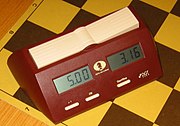Game clock
From Wikipedia, the free ecyclopedia.
A game clock consists of two adjacent clocks and buttons to stop one clock while starting the other, such that the two component clocks never run simultaneously. Game clocks are used in two-player games where the players move in turn. The purpose is to keep track of the total time each player takes for his or her own moves, and ensure that neither player overly delays the game.
Game clocks were first used extensively in tournament chess, and are often referred to as "chess clocks," but their use has since been adopted for tournament Scrabble, Shogi, Go, and nearly every competitive two-player board game.
The simplest time control is "sudden death", in which players must make a predetermined number of moves in a certain amount of time or forfeit immediately. A particularly popular variant in informal play is blitz chess, in which each player is given five minutes on the clock for the entire game.
The players may take more or less time over any individual move. The opening moves in chess are often played quickly due to their familiarity, which leaves the players more time to consider more complex and unfamiliar positions later. It is not rare in slow chess games for a player to leave the table, but the clock of the absent player continues to run if it is his turn, and/or starts to run if his opponent makes a move.
Analog clocks (as pictured above right) are equipped with a "flag" (a Dutch invention) that falls to indicate the exact moment the player's time has expired. Unfortunately, additional time can't easily be added for more complex time controls, especially those which call for an increment or delay on every move, such as some forms of byoyomi. Therefore more versatile digital clocks are becoming increasingly popular.
Digital clocks and Internet gaming have spurred a wave of experimentation with more varied and complex time controls than the traditional standards. One particularly notable development, which has gained quite wide acceptance in chess, was proposed by former world champion Bobby Fischer, who in 1988 filed for U.S. Patent #4,884,255 (awarded in 1989) for a new type of digital chess clock. Fischer's digital clock gave each player a fixed period of time at the start of the game and then added a small amount after each move. In this way, the players would never be desperately short of time, but games could also be completed more quickly, doing away with the need for adjournments (in which a game is left incomplete to be finished at a later date). Although it was slow to catch on, as of 2004 a very large number of top class tournaments use Fischer's system, though usually in combination with the more traditional (at lower levels, more traditional clocks are still employed as they are cheaper). Other aspects of Fischer's patent, such as a synthesized voice announcing how much time the players have, thus eliminating the need for them to keep looking at the clock, have not been adopted.
External links
Categories: Games | Clocks | Chess



